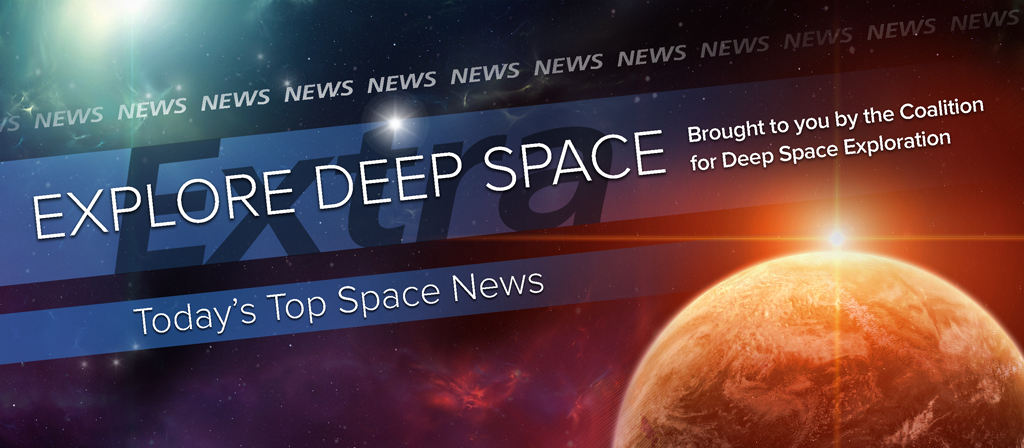Today’s Deep Space Extra offers the latest reporting and commentary on space related activities from across the globe. Emerging telepresence and virtual reality technologies could help U.S. astronauts explore the Martian surface from orbit around the red planet. NASA scientists/engineers have developed a portable chemical lab able to identify possible biological activity on other planets. Planet or not Pluto is fascinating, says astrophysicist Neil deGrasse Tyson. Telescopes catch planet formation in the act. NASA’s Mars Curiosity rover heads for unexplored sand dunes. Japan’s Akatsuki spacecraft nears a second opportunity to maneuver into orbit around Venus. Russia and Iran find common ground in space, Earth observation. Boeing’s CST-100 Starliner achieves development milestones in efforts to begin U.S. commercial launches of astronauts to the International Space Station. NASA Administrator Charles Bolden urges the space industry on in efforts to place space activities in low Earth orbit in the hands of the private sector. A new report raises concerns over Chinese space capabilities.
Human Deep Space Exploration
Almost like
Air and Space Museum Magazine (12/1): Experts believe telepresence and virtual reality technologies could help human explorers learn more about the Martian surface from orbit. The prospect, part of a NASA/Jet Propulsion Laboratory study, could mean astronauts operate exploratory robots and rovers on the Martian terrain from an orbital spacecraft before NASA undertakes a more expensive mission equipped to land with humans.
Unmanned Deep Space Exploration
Meet the trailblazing NASA team developing a totally automated space lab
Forbes.com (11/18): At NASA’s Jet Propulsion Laboratory, a young science/engineering team has developed a portable chemistry lab with the sophistication to identify chemical signatures associated with biological activity. The possible future destinations for the chemical lab include Mars, Jupiter’s moon Europa and Saturn’s moon Enceladus.
Q&A: Neil deGrasse Tyson weighs in on New Horizons’ Pluto discoveries
Astrobiology Magazine (11/18): Pluto may not meet the definition of planet, but the distant Kuiper Belt Object, with its surface water ice deposits, rugged terrain and a blue haze, is still fascinating, says Tyson, astrophysicist and Hayden Planetarium director.
Planet formation caught in the act
Science News (11/18): Astronomers have imaged planets in the making around a star 450 light years from the Earth. The findings were reported this week in the journal Nature.
Mars rover steers toward active sand dunes
Spaceflightnow.com (11/18): NASA’s Curiosity rover, exploring the Martian surface at Mount Sharp, is headed for a mound of unexplored sand stretched across the base of the three mile high peak, where it will sample and test the soil and dig to find out what lies below. The sand poses a challenge — the rover’s Earth based drivers must be cautious to keep the rover from becoming stuck in the soft soil.
Tiny thrusters to do heavy lifting as Japanese probe approaches Venus
Spaceflightnow.com (11/18): Japan’s Akatsuki spacecraft has a second date with Venus on Dec. 7. Thrusters on the spacecraft are to burn for 20 minutes, slowing the probe into orbit. Japanese experts rescued the mission after the first attempt to maneuver into orbit around Venus in late 2010 was thwarted by a faulty propulsion system valve. Once known as the Venus Climate Orbiter, Akatsuki was launched in May 2010.
Low Earth Orbit
Russia and Iran to cooperate in space research deputy PM
TASS, of Russia (11/18): The cooperation will include Earth observations, according to remarks from Russian Deputy Prime Minister Dmitry Rogozin during a visit to Iran this week.
Commercial to Low Earth Orbit
Boeing and NASA progress through critical CST-100 Starliner milestones
Nasaspaceflight.com (11/18): Boeing is meeting development objectives for the CST-100 Starliner, the spacecraft the company is developing under NASA’s Commercial Crew Program to begin launching astronauts to the International Space Station. Boeing is looking to the spring of 2017 for its inaugural launch of the new spacecraft.
Private companies will help NASA get to Mars, space agency chief says
Space.com (11/18): In opening remarks at the SpaceCom conference in Houston this week, NASA Administrator Charles Bolden called on the commercial space industry to fill the low Earth orbit role now occupied by NASA and other government space agencies. As activities aboard the International Space Station, now anticipated to conclude in 2024, draw to a close, NASA plans to refocus its efforts on human deep space exploration and a Mars landing in the mid-2030s.
U.S.-China commission wants review of export restrictions
Spacepolicyonline.com (11/18): China’s space capabilities continue to increase in ways that further the country’s national security, economic and political objectives, according to a report from the U.S.-China Economic and Security Review Commission. The concerns raised in the report include China’s efforts to increase its share of the global launch services market; current anti-satellite capabilities, both direct ascent and satellite co-orbiting capabilities; as well as plans to launch an independent space station in 2022.

